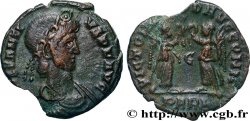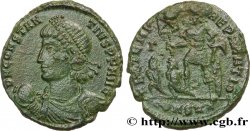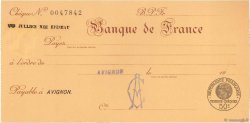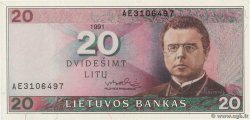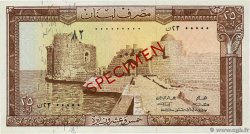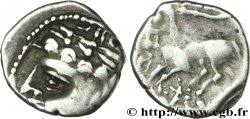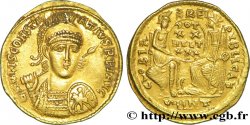v38_1291 - CONSTANCIO II Solidus
MONNAIES 38 (2009)
Precio de inicio : 950.00 €
Valoración : 1 800.00 €
Precio realizado : 1 310.00 €
Número de ofertas : 3
Oferta más alta : 1 520.00 €
Precio de inicio : 950.00 €
Valoración : 1 800.00 €
Precio realizado : 1 310.00 €
Número de ofertas : 3
Oferta más alta : 1 520.00 €
Tipo : Solidus
Fecha: c. 350-360
Nombre del taller / ciudad: Bithynie, Nicomédie
Metal: oro
Milésimas de pureza : 1000 ‰
Diámetro: 21,5 mm
Eje de acuñación: 12 h.
Peso: 4,45 g.
Grado de rareza: UNIQUE
Officine: 3e
Comentarios sobre el estado de conservación:
Exemplaire sur un flan large et parfaitement centré des deux côtés. Superbe portrait, finement détaillé, en particulier au niveau du bouclier. Très joli revers, bien venu à la frappe
N° en los catálogos de referencia :
Anverso
Titulatura del anverso: DN VLIS CONSTAN-TIVS RPI AVG (SIC !).
Descripción del anverso: Buste diadémé, casqué et cuirassé de Constance II auguste de face, tenant de la main droite la haste qui repose sur l'épaule et de la gauche, un bouclier orné d'un cavalier chargeant à gauche et terrassant un fantassin (N'a) ; diadème perlé.
Traducción del anverso: “Flavius Iulius Constantius Perpetuus Augustus”, (Flavien Jules Constance perpétuel auguste).
Reverso
Titulatura del reverso: GLORIA - REI - PVBLICAE/ VOT/ XX/ MVLT/ XXX/ -|- SMNT (SIC !).
Descripción del reverso: Rome et Constantinople assises de face sur une banquette, tenant ensemble un bouclier ; Rome est assise de face et tient un trophée de la main gauche qui repose sur son épaule ; Constantinople est assise à droite, tournée à gauche, le pied droit posé sur une proue de navire.
Traducción del reverso: “Gloria Reipublicæ/ Votis vicennalibus/ Multis tricennalibus”, (La gloire du bien public/ Vœux pour le vingtième anniversaire de règne et plus pour les trente à venir).
Comentario
Imitation de très bon style, mais fauté associant un droit de 351-355 (buste casqué et cuirassé de face) avec un revers de 340-350 (avec la mention des vota VOT/ XX/ MVLT/ XXX). Plusieurs fautes d’orthographe dans la légende du droit sont à relever avec DN ou EN pour Flavius, VLIS pour Julius, RPI pour PERP. Au revers le S de marque d’atelier est couché. Portrait et revers semblent légèrement stylisés. Ce solidus a pu être frappé de l’autre côté du limes par les Goths (Ostrogoths), imitant directement un prototype ou deux prototypes afin de les faire circuler dans des régions qui n’étaient pas fortement romanisées . Rubans de type 3 aux extrémités bouletées. Casque diadémé avec plumet. Cuirasse cloutée et décorée. Épaulière ornée. Sur cet exemplaire, le cavalier chargeant est tourné à gauche et le fantassin n’est pratiquement pas visible. Semble complètement inédit et non recensé. Ne semble pas avoir été signalé. De la plus grande rareté et du plus grand intérêt numismatique.
Very good style imitation, but faulty, combining a right of 351-355 (helmeted and cuirassed bust facing) with a reverse of 340-350 (with the mention of the votes VOT/ XX/ MVLT/ XXX). Several spelling errors in the legend of the right are to be noted with DN or EN for Flavius, VLIS for Julius, RPI for PERP. On the reverse the S of the mint mark is lying down. Portrait and reverse seem slightly stylized. This solidus could have been struck on the other side of the limes by the Goths (Ostrogoths), directly imitating a prototype or two prototypes in order to circulate them in regions that were not strongly Romanized. Type 3 ribbons with pelleted ends. Diademed helmet with plume. Studded and decorated cuirass. Decorated shoulder pad. On this example, the charging rider is turned to the left and the infantryman is practically not visible. Appears to be completely unpublished and unrecorded. Does not appear to have been reported. Of the greatest rarity and numismatic interest.
Very good style imitation, but faulty, combining a right of 351-355 (helmeted and cuirassed bust facing) with a reverse of 340-350 (with the mention of the votes VOT/ XX/ MVLT/ XXX). Several spelling errors in the legend of the right are to be noted with DN or EN for Flavius, VLIS for Julius, RPI for PERP. On the reverse the S of the mint mark is lying down. Portrait and reverse seem slightly stylized. This solidus could have been struck on the other side of the limes by the Goths (Ostrogoths), directly imitating a prototype or two prototypes in order to circulate them in regions that were not strongly Romanized. Type 3 ribbons with pelleted ends. Diademed helmet with plume. Studded and decorated cuirass. Decorated shoulder pad. On this example, the charging rider is turned to the left and the infantryman is practically not visible. Appears to be completely unpublished and unrecorded. Does not appear to have been reported. Of the greatest rarity and numismatic interest.








 Informar de un error
Informar de un error Imprimir la página
Imprimir la página Comparte mi selección
Comparte mi selección Haz una pregunta
Haz una pregunta Consignar / vender
Consignar / vender
 Descriptivo
Descriptivo

